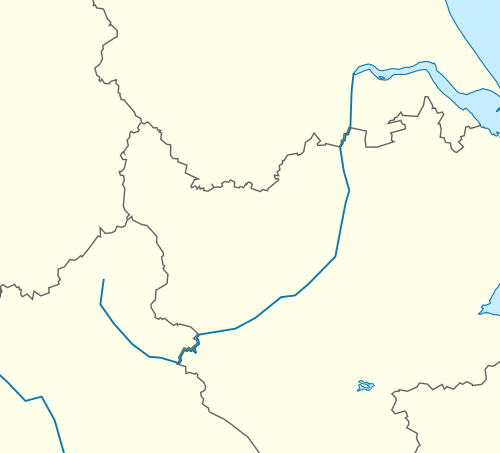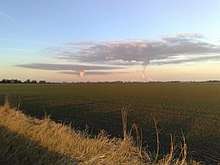Megawatt Valley
Megawatt Valley is a term applied to a geographic location which houses a large number of electricity generating stations. Historically in the United Kingdom this applied to the coal-fired power stations of the lower Trent Valley. In the mid-1980s, the valley's 13 facilities generated up to a quarter of the power demand for England and Wales. A shift to gas-fired power stations saw many of the Megawatt Valley facilities close down. The term was then associated with an area of Yorkshire centred on the River Aire that was home to Ferrybridge C, Eggborough and Drax power stations. Of these facilities only Drax remains in operation. In the United States the term has been applied to an area of West Virginia, home to five power stations.

Trent Valley
.jpg)
Megawatt Valley was a term originally applied to the Trent Valley.[1] The area was developed in the 1960s by the nationalised Central Electricity Generating Board (CEGB).[2] Many coal power stations were constructed on or near the banks of the River Trent and a major overhead power line network was constructed to supply Southern England.[2][3] This construction coincided with a move by CEGB to shift the location of power generation from smaller city-based power stations to rural locations. These were more efficient as they could be larger, closer to fuel sources and cooling water supplies. The Trent Valley was ideal due its proximity to the Nottinghamshire and Yorkshire coal fields and ready supply of water from the Trent.[3]
Power stations in Megawatt Valley included High Marnham in Nottinghamshire which, at 1000MW, was the largest power station in Europe when it was opened in October 1962, and was fed by 17 different collieries.[4] In 1986 the valley was home to 13 of the 78 power stations in England and Wales and was responsible for up to a quarter of all power generated in the same area.[5][6] This was the largest concentration of power generation in Europe.[3] It was said that by the late 1960s the waters of the Trent were noticeably warmer than those of comparable rivers owing to heat transfer from the cooling water.[7]
The sculpture Power in Trust by Norman Sillman, made to represent a hand made from boiler pipes and a turbine, was commissioned in 1961 for the opening of Staythorpe B Power Station.[8] It remains on the site of the former coal-fired power station and has been described as a monument to the pioneers of Megawatt Valley.[6] The five surviving cooling towers at the long-closed Willington Power Station were preserved from demolition due to the presence of nesting birds. They remain a notable landmark to travellers along the Trent and have been cited as a monument to the importance of the Trent to Megawatt Valley.[9]
A 1989 paper written by the Chairman of East Midlands Electricity, then on the brink of privatisation, stated that until that point British electricity generation had relied on large-scale coal plant as seen at Megawatt Valley. He provided a vision of the future where generation moved away from coal to cheaper means, such as gas.[10] This switch began to be made in the 1990s, during the so-called Dash for Gas, and led to the closure of many coal-fired plants, including those in Megawatt Valley.[11] Only Ratcliffe-on-Soar, Cottam and West Burton remain in service of the coal-fired power stations in the Megawatt Valley (as of 2017).[12] These three plants have flue-gas desulphurisation units which supply gypsum for plasterboard manufacture.[13]
There remains a concern amongst some residents that the old coal power stations will be replaced by other forms of generation such as wind turbines and that Megawatt Valley will continue to be viewed as a place where visual intrusion by energy assets is acceptable.[14]
List of coal power stations in the lower Trent Valley

Richard Stone, in his book The River Trent (2005), provides the limits of Megawatt Valley as Meaford – near Stone, Staffordshire – at the upstream end and Keadby – near Scunthorpe, Lincolnshire at the downstream end. This includes the following coal-fired power stations – some of these sites have had gas-fired units installed, these are not listed.[15]
Staffordshire
Derbyshire
- Drakelow A (1955–1984)[20]
- Drakelow B (1960–1993)[18][20]
- Drakelow C (1964–2003)[18][20]
- Willington A (1957–1994)[21][22][23]
- Willington B (1960–1999)[22][23]
Leicestershire
- Castle Donington (1958–1995)[24][25]
Nottinghamshire
- Ratcliffe-on-Soar (1968–)[26]
- Wilford (1925–1981)[27][28]
- Staythorpe A (1950–1983)[29][30]
- Staythorpe B (1962–1994)[29]
- High Marnham (1962–2003)[24][31]
- Cottam (1969–2019)[32]
- West Burton (1968–)[33][34]
Later use of the term

After many of the Trent Valley power stations closed the epithet Megawatt Valley began to be used for a section of Yorkshire between Leeds, York and Doncaster. This was due to the presence of Ferrybridge C (1966–2016), Eggborough (1967–2018) and Drax (1974–) coal-fired power stations.[36] This is one of the few remaining concentrations of British coal-fired generation, the power stations are located close to historic coal-mining sites on the South Yorkshire Coalfield and to the River Aire.[37] Drax is a large power station capable of generating 7% of UK electricity demand and, despite being the UK's cleanest and most-efficient coal-fired power station is Europe's biggest single source of carbon dioxide emissions.[38] The term Megawatt Valley, in relation to the Yorkshire power stations, has been mentioned ("What ever happened to The Megawatt Valley? It pumped out the sounds to the avenues and alleys") in the song Two Lane Texaco by the folk band My Darling Clementine.[39]
The term has also been used in reference to a location in West Virginia, United States, where five plants are located, totalling some 6000 megawatts of generating capacity. This includes the Mountaineer Power Plant, in Mason County and four nearby plants.[40]
References
- Fort, Tom (2008). Downstream. Century. p. 99. ISBN 9781846051692.
- "Engineering Design for Sustainable Development". Centre for Applied Research in Educational Technologies. University of Cambridge. Archived from the original on 26 May 2003. Retrieved 21 October 2017.
- 20th-Century Coaland Oil-Fired Electric Power Generation: Introductions to Heritage Assets. Historic England. June 2015. p. 8.
- 20th-Century Coaland Oil-Fired Electric Power Generation: Introductions to Heritage Assets. Historic England. June 2015. p. 7.
- The East Midland Geographer. Department of Geography, University of Nottingham. 1986. p. 30.
- "Crossing England in a Punt: River of Dreams". BBC Four. Retrieved 21 October 2017.
- Your Environment – No.1 Winter 69. 1970. p. 15.
- "RWE npower – who we are" (PDF). npower. Retrieved 18 February 2020.
- Hewitt, Tony A. J. (2015). River Trent: From Source to Sea. Amberley Publishing Limited. ISBN 9781445649986.
- Andrews, S; Harris, J F; Morgan, R; Robinson, C. "Prospects for Independent Power Generation" (PDF). Surrey Energy Economics Centre. p. 14.
- Osborne, Hilary (28 March 2007). "Emissions from UK power stations soar". The Guardian.
- "Countdown to 2025: Tracking the UK coal phase out". Carbon Brief. 10 February 2016. Retrieved 24 October 2017.
- Stone, Richard (2005). The River Trent. Chichester, West Sussex: Phillimore. p. 122. ISBN 1 86077 356 7.
- "Planning Committee Minutes 5 August 2014" (PDF). Newark and Sherwood District Council.
- Stone, Richard (2005). The River Trent. Chichester, West Sussex: Phillimore. pp. 121–122. ISBN 1 86077 356 7.
- The Engineer. Morgan-Grampian (Publishers). 1957. p. 533.
- "The Meaford Energy (Gas Fired Power Station) Order – 6.4.8 Volume 4: Environmental Statement Appendix 13.6: Geo-environmental Desk Study" (PDF). National Infrastructure Planning Inspectorate. Meaford Energy Centre. Retrieved 24 October 2017.
- Edgar, Gordon (2017). Industrial Locomotives & Railways of The Midlands. Amberley Publishing. ISBN 9781445649351.
- "Rugeley power station closes weeks earlier than expected". Express and Star. 8 June 2016. Retrieved 24 October 2017.
- "South Derbyshire Local Plan Part 2" (PDF). South Derbyshire District Council.
- Palmer, John (2017). Midland Main Lines to St Pancras and Cross Country: Sheffield to Bristol 1957 – 1963. Pen and Sword. ISBN 9781473885592.
- "Pastscape – Detailed Result: MONUMENT NO. 1473304". Pastscape. Historic England. Retrieved 24 October 2017.
- "Willington C Gas Pipeline Environmental Statement Appendix 6.3 Willington Power Station, Willington, Derbyshire. Remediation Options Appraisal" (PDF). National Infrastructure Planning Inspectorate. nPower. Retrieved 24 October 2017.
- "'High Merit': existing English post-war coal and oil-fired power stations in context" (PDF). Historic England. Archived from the original on 2016-12-20. Retrieved 2017-10-24.
- "Castle Donington Conservation Area Appraisal and Study" (PDF). North West Leicestershire District Council. Retrieved 25 October 2017.
- Russell, Dan (12 August 2017). "In pictures: Construction of Ratcliffe-on-Soar power station". Nottingham Post. Retrieved 24 October 2017.
- "Firm that 'built city' reaches 150 years". BBC News. 30 April 2017. Retrieved 24 October 2017.
- "Luncheon on opening of North Wilford Power Station". Nottinghamshire County Council. Retrieved 25 October 2017.
- "End of an era as club closes after 62 years | Newark Advertiser". Newark Advertiser. Retrieved 24 October 2017.
- Jackson, Allen (2015). Contemporary Perspective on LMS Railway Signalling Vol 1: Semaphore Swansong. Crowood. ISBN 9781785000263.
- "Power station towers demolished". BBC News. 15 July 2012.
- "Cottam Power Station powers down after half a century". EDF Energy. Retrieved 1 October 2019.
- "Seven up: the last operating coal plants in the UK". powertechnology.com. 10 July 2019. Retrieved 11 June 2020.
- "UK's last coal power stations". The Guardian. 7 February 2019. Retrieved 11 June 2020.
- "Cultural Heritage Desk Based Assessment" (PDF). Scottish and Southern Energy. Retrieved 24 October 2017.
- "Renewable Energy : The North's Future, Sector by Sector". Big Issue North: 4. 21 October 2016. Retrieved 22 October 2017.
- "Mapped: How the UK generates its electricity | Carbon Brief". Carbon Brief. 12 October 2015. Retrieved 22 October 2017.
- Harris, John (14 April 2007). "The Burning Issue". The Guardian. Retrieved 22 October 2017.
- "My Darling Clementine: Still Testifying | Folk Radio UK". Folk Radio UK. Folk Music Magazine. 6 June 2017. Retrieved 22 October 2017.
- Kaku, Michio (2012). Physics of the Future: The Inventions that Will Transform Our Lives. Penguin. ISBN 9780141044248.